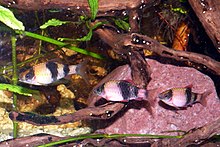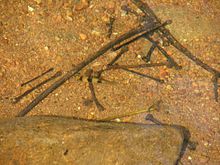| Melon barb | |
|---|---|

| |
| Conservation status | |
 Least Concern (IUCN 3.1) | |
| Scientific classification | |
| Domain: | Eukaryota |
| Kingdom: | Animalia |
| Phylum: | Chordata |
| Class: | Actinopterygii |
| Order: | Cypriniformes |
| Family: | Cyprinidae |
| Subfamily: | Barbinae |
| Genus: | Haludaria |
| Species: | H. fasciata |
| Binomial name | |
| Haludaria fasciata (Jerdon, 1849) | |
| Synonyms | |
| |
The melon barb (Haludaria fasciata) is a common species of cyprinid fish that is endemic to rivers in Goa, Karnataka, Kerala and Tamil Nadu in the Western Ghats of South India. They live in a tropical climate in water that typically has a pH of 6.0—6.5, a water hardness of around 5 dGH, and a temperature range of 22–26 °C (72–79 °F). It grows to a length of 6 centimetres (2.4 in). This species can also be found in the aquarium trade.

The melon barb is an open water, substrate egg-scatterer, and adults do not guard the eggs. Males in breeding condition flush red and develop fine nuptial tubercles on their snouts, used for bumping and rubbing the females to induce egg release.
See also
References
- ^ Abraham, R. (2015). "Haludaria fasciata". IUCN Red List of Threatened Species. 2015: e.T172367A70085467. doi:10.2305/IUCN.UK.2015-1.RLTS.T172367A70085467.en. Retrieved 25 April 2024.
- Bailly, Nicolas (2022). "Haludaria fasciata (Jerdon, 1849)". WoRMS. World Register of Marine Species. Retrieved 25 April 2024.
- ^ Froese, Rainer; Pauly, Daniel (eds.). "Haludaria fasciata". FishBase. October 2013 version.
- Judine John Chacko; N Mini Sekharan (September 2022). "Sexual dimorphism in structures, size and shape of the cyprinid Nilgiri melon barb, Haludaria fasciata". Fisheries & Aquatic Life. 30 (3): 138–148. doi:10.2478/aopf-2022-0013.
| Taxon identifiers | |
|---|---|
| Haludaria fasciata | |
| Puntius fasciatus | |
| Cirrhinus fasciatus | |
This Barbinae-related article is a stub. You can help Misplaced Pages by expanding it. |